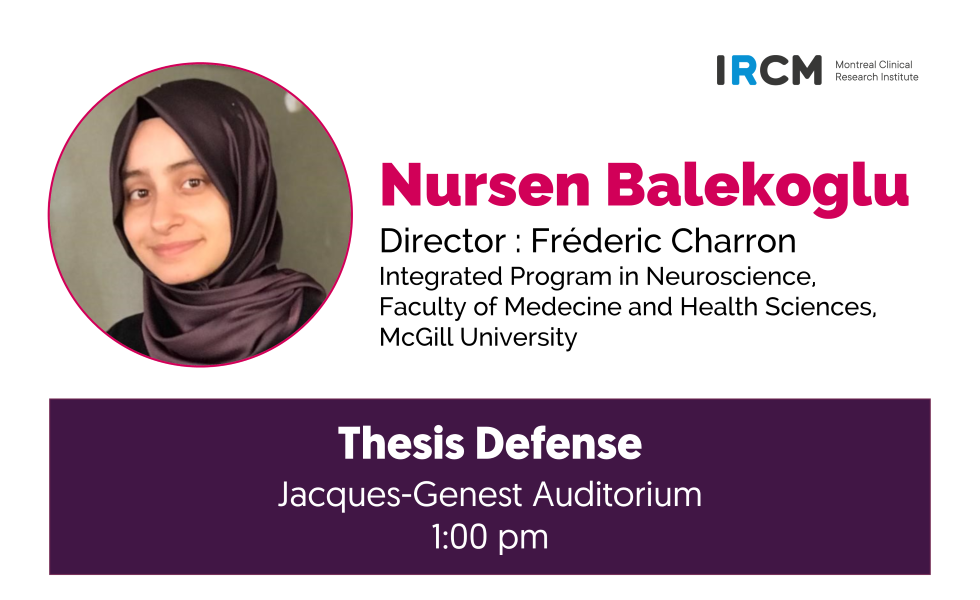
-
Careers • News • Contact us •
- Login
- Français
Events to come
Jul 27, 2023
Location
IRCM110, avenue des PinsMontréal, H2W 1R7
ContactMyrna.khuon@ircm.qc.ca
Thesis Defense, July 27, 2023
Thesis defense - Nursen Balekoglu

Molecular mechanisms of spinal commissural axon guidance
Nursen Balekoglu
Director : Fréderic Charron
In person:
IRCM Auditorium
110, avenue des Pins O, H2W 1R7 Montreal
Online:
Zoom link: https://zoom.us/j/99045678554
ID: 990 4567 8554
Code: 979343
Summary
The proper establishment of neural circuitry requires that axons navigate over long distances to reach their targets during nervous system development. Attractive and repulsive guidance cues in the extracellular environment guide axons in their pathfinding. Guidance cues bind to their receptors in the growth cone, the motile structure at the tip of growing axons, and promote the signaling cascade for remodeling of the growth cone actin cytoskeleton. Netrin-1 and Sonic hedgehog (Shh) are two major guidance cues that attract axons of commissural neurons to the ventral midline through their receptors Dcc and Boc, respectively. In Chapter 4, we study Netrin-1/Dcc signaling. Mutations in Netrin-1/DCC signaling have been linked to mirror movements (MM) disorder, which is characterized by involuntary mirroring of the voluntary movements of one side of the body on the opposite side of the body. An autosomal dominant mutation was found in ARHGEF7 in a familial case of MM. Arhgef7 is a Rho GEF that activates the Rho GTPases Rac1 and Cdc42, which are molecular switches for actin cytoskeleton remodeling. My contribution was to investigate the in vivo requirement of Arhgef7 for spinal cord commissural axon guidance in mice heterozygous for Arhgef7 (Arhgef7het). We found that Arhgef7het mice show defects in the trajectories of commissural axons in embryonic spinal cords. The commissural axon bundle is more dispersed and wider in the ventral spinal cord of Arhgef7het male embryos compared to control. We also found that Arhgef7het male adults have defects in the lateralization of motor control in the ladder rung assay. This indicates a MM-like phenotype consistent with the defects observed in commissural axon trajectories in their spinal cord. In Chapter 5, we investigated how Boc regulates cytoskeletal remodeling in response to Shh. We screened for Boc-interacting proteins in a proximity-dependent biotinylation assay (BioID) and found the WAVE regulatory complex (WRC) as a strong candidate. The WRC is a heteropentameric complex consisting of NCKAP1/1L, CYFIP1/2, ABI1/2/3, WAVE1/2/3, and BRK1. The WRC acts downstream of Rac1 to promote actin cytoskeleton remodeling. Therefore, we hypothesized that the WRC may be important for Shh-mediated growth cone guidance. Using biochemical assays, we showed that Boc interacts with the WRC and this interaction is regulated by Shh. Moreover, knockdown of Nckap1 or Cyfip1/2 in spinal commissural neurons prevents turning of axons toward a Shh gradient in vitro, indicating that the WRC is required for Shh[1]mediated attraction of axons. In addition to our finding of the WRC as an effector of Boc, the WRC has also been linked to some other guidance receptors which act in guidance of commissural axons. Thus, in Chapter 6, we investigated the in vivo requirement of Nckap1 in spinal cord commissural axon guidance. We used different Cre drivers to conditionally delete Nckap1 in mice at different time points and/or in different populations of commissural neurons during development and analyzed the spinal cord commissural axon trajectories of those mice at embryonic stages. This helps to understand the role of Nckap1 and, thus, the role of WRC in the guidance of spinal commissural axons. This study contributes to our understanding of the molecular mechanisms underlying Netrin-1/Dcc and Shh/Boc mediated axon guidance by identifying effectors linking Dcc and Boc to the actin cytoskeleton.

© Montreal Clinical Research Institute, Année.All rights reserves. | Privacy policy | Terms of use | Web site by Agence Riposte


